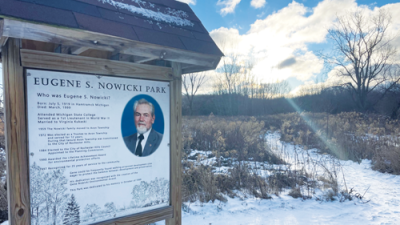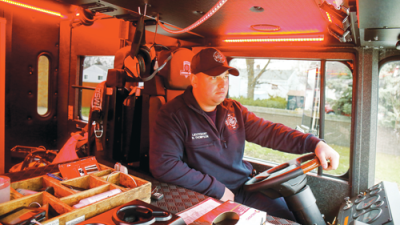WARREN — At their Jan. 10 meeting, Warren City Council members voted unanimously to approve a $112,984 cost-sharing agreement with Macomb County for engineering designs linked to a construction project along Mound Road from Eight Mile Road to Interstate 696.
Although Council members and the community were in agreement about the need to have this section of Mound Road repaired, the cost and the timing were major points of contention.
“The county has the audacity to tell us, you’ve got to pony up some more money,” said Councilman Eddie Kabacinski, who represents the Warren City Council’s District 5. “That is absolutely ridiculous. It’s a county road.”
Mound Road is a county road according to Macomb County Department of Roads Director Bryan Santo.
“Mound Road is under Macomb County jurisdiction. Road jurisdictions are determined by their federal road classification. In Warren, Mound Road, Dequindre Road, Schoenherr Road, Hayes Road, and all even numbered mile roads are under Macomb County jurisdiction,” said Santo. “The remaining roads in Warren are under city jurisdiction, including all residential streets.”
According to Macomb County Commissioner Michelle Nard, cost sharing is customary between the city and the county.
“If you look at Sterling Heights, Sterling Heights had no problem participating in the cost sharing agreement with it (Mound Road),” she said. “The other cities going up that road (Mound Road) shared in the cost of whatever it took to get that road done.”
Nard represents District 12 on the Macomb County Board of Commissioners, which includes the area of Mound from Eight Mile to I-696.
Cost sharing is not only custom and practice — it is the law.
“As with all road projects within Macomb County, local community participation is statutorily required,” said Santo. “Primary roads such as Mound Road are split between Macomb County, which pays 50%, and the local community, which pays 50%. If federal funding is included in a project, federal funds are applied and the remaining project costs are split 50-50 between Macomb County and the local community.”
With so much money being poured into the Innovate Mound project, Warren residents wanted to know if the Eight Mile Road to I-696 section of Mound Road was included. According to Nard, this section is not part of Innovate Mound.
“Based on the industrial and manufacturing density and economic impact of Mound Road between I-696 to M-59, the parameters for the Innovate Mound project were selected by Macomb County and the cities of Warren and Sterling Heights to maximize the chance of receiving federal funding for reconstruction,” said Santo.
According to Santo, the $230 million Innovate Mound project is supported by Michigan political representatives in Washington, D.C., along with local community partners and business leaders. The project received a $98 million Infrastructure for Rebuilding America grant.
Some Warren residents expressed that north Warren reaps the benefits, while south Warren is ignored.
“Mound Road is a sterling example of the inequities of this city,” said Michael Howard. “South Warren, what do we see?”
“Macomb County is working on securing additional federal funding for Mound Road, from Eight Mile Road to I-696. Due to the reconstruction work required on Mound Road, south of I-696, a project would not be economically feasible with county and local community funds alone,” said Santo. “Similar to Innovate Mound, Macomb County, Warren and community stakeholders will be pursuing federal funding and grant opportunities for the reconstruction of Mound Road between Eight Mile Road to I-696.”
The current Warren City Council was not assembled and did not have the opportunity to weigh in on decisions regarding the Innovate Mound project. Council members doubt the Mound Road from Eight Mile to I-696 work will compare to the road construction starting at 11 Mile and going north on Mound.
“I am not sure if Eight Mile to 11 Mile is going to match the same technology that is put in at 11 Mile going north,” Councilwoman Mindy Moore said. “I think it’s going to be a slimmed down version of reconstruction.”
The technology in the Innovate Mound project includes new pavement, drainage, curbs and driveways, traffic signal optimization, roadway widening, connected vehicle and fiber optic communications technology, enhanced nonmotorized facilities and energy-efficient lighting.
This technology on Mound Road will help reduce congestion through improved design and smart technologies such as Intelligent Transportation Systems, traffic signals and signs, connected vehicle pilot projects, and real-time traffic speed monitoring, according to Santo.
The Mound Road Eight Mile to I-696 project may include similar technologies; however, it is dependent on a variety of factors, which include available federal funding, community needs, and the results of the preliminary engineering study to determine the most effective and efficient way to rebuild the remaining portion of Mound Road, said Santo.
Council Members questioned the timing of this project and thought it should have been done sooner.
“We (the south end) should not have been the last to be considered,” said Kabacinski. “It should have been the first to be done. It would have alleviated a lot of congestion that was happening during the summer construction season.”
 Publication select ▼
Publication select ▼
















